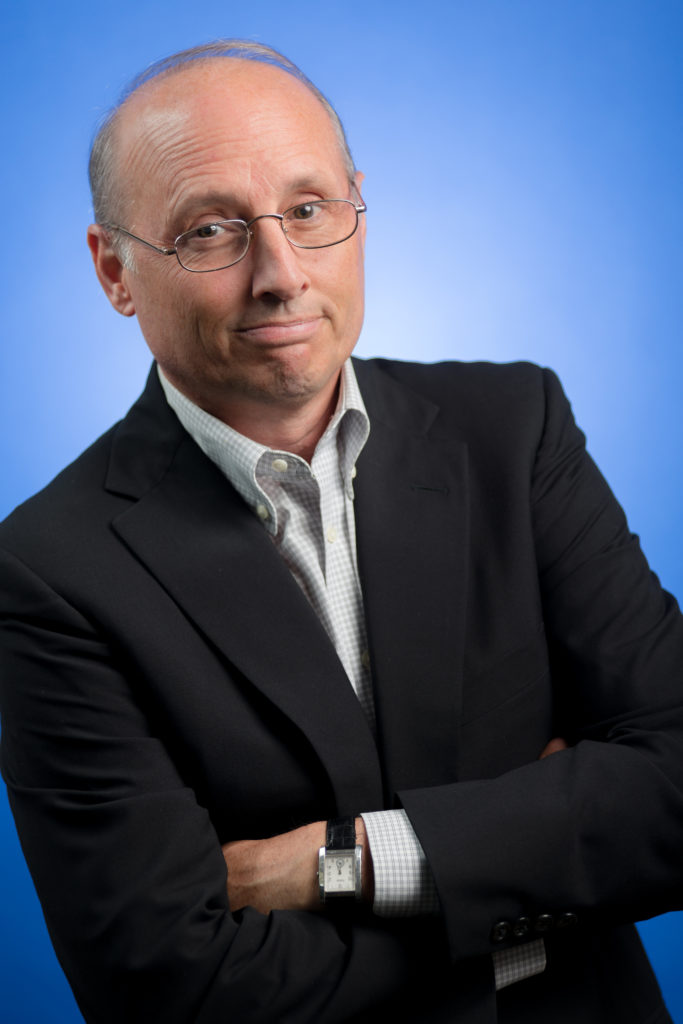I’ve known Gordon Borrell for well more than a decade now, and always find his local digital revenue mission compelling. Back in 2006, Gordon spoke at our Jacobs Media Summit, challenging radio broadcasters to step it up and hire dedicated digital sellers.
During that same speech, Gordon played the video below to get the crowd warmed up. Take 82 seconds and watch it now.
That little exercise was a reminder to everyone in the room that sometimes the obvious is right before your very eyes – but you can’t see it because you’re so focused on the task at hand. In this case, Gordon was talking about local digital revenue – and his premise was that legacy media brands often get so myopic about their sales goals and traditional revenue streams, they miss the bigger opportunity. In this case, “the gorilla in the room.”
Since then, Gordon has made it his mission to champion local digital sales. And based on the upward trajectory of this category in radio, he’s clearly been on the right side of the argument all along.
Back in 2009, Borrell created his first Local Online Advertising Conference. LOAC is a fascinating mélange of media pros, representing newspapers, television, radio, and other traditional media all trying to make their way through the digital tall grass. I’ve been in attendance in past years, and presented a “connected car” session back in 2016. Gordon typically attracts upwards of 400 executives, eager to gain insight into how traditional media companies can transition to integrated ad models.
I’ll be back on the LOAC stage again next month (more on that later). A look at the agenda shows there’s a lot of meat on the bone for radio I had a chance to ask Gordon a few questions about the conference, and the state of local digital advertising.
I had a chance to ask Gordon a few questions about the conference, and the state of local digital advertising.
FJ: Gordon, looking over the agenda for LOAC, it strikes me radio is clearly going to be a topic of conversation. What’s the story?
Gordon Borrell: There is a bigger emphasis, mostly because radio has been very active in the digital space in the past two years. Cumulus launched a digital services unit, C-Suite, last summer, Urban One beefed up its digital team and offerings, and several others are doubling down. In fact, the percentage of stations selling digital services such as SEO and website development has jumped from 37% a year ago to 58% in our most recent survey.
FJ: That’s serious progress. You and your company have a reputation for following the money, which means you tend to turn your nose up at early-stage platforms that don’t generate any revenue. Tell us about podcasting and smart speakers. Have they hit the Borrell radar yet, or are they still too “revenue poor” for you to consider them worth tracking?
GB: There are way too many new digital toys to track, so we rely on the billion-dollar litmus test. That is, we don’t pay much attention to something until it generates $1 billion in advertising or subscription revenue. That milestone hasn’t been reached for podcasting and smart speakers, but the usage trajectory tells us it will be soon. So we’re paying attention to these new platforms.
FJ: Radio has been buzzing about smart speakers for more than a year now. Many broadcasters feel these gadgets could replace those disappearing radios in people’s homes and workplaces. Where do you think smart speakers are headed, and what should the radio industry be doing today to prepare?
GB: Smart speakers are especially intriguing because the business model goes well beyond advertising and into ecommerce. You can order pizza, concert tickets, or a plumber. It’s a radio robot. Preparing is easy — just jump the hell in. If your station doesn’t have a skill on Alexa or Google Home, get one and learn. Turn it over to your marketing department, not your PD. I think the goal ought to be for your station to “own” Alexa in your markets. In short, treat smart speakers as the industry treated FM in the 1970s. It’s a new and exciting audio channel.
 QUESTION: Gordon, my PD buddies might not love that advice, but I understand how the marketer in you sees big opportunities with smart speakers. But thinking about the corner office, you’ve got a session where CEOs – including Caroline Beasley – are going to be asked whether digital is “front and center” at their companies, or whether it’s treated merely as a complement to their core product. What’s behind that question?
QUESTION: Gordon, my PD buddies might not love that advice, but I understand how the marketer in you sees big opportunities with smart speakers. But thinking about the corner office, you’ve got a session where CEOs – including Caroline Beasley – are going to be asked whether digital is “front and center” at their companies, or whether it’s treated merely as a complement to their core product. What’s behind that question?
GB: A survey of about 200 media managers late last year showed there’s a great deal of frustration among those hired to manage digital operations. On one hand, there’s the need to maintain the flow of high-margin revenue from the core product, and on the other hand is an exciting new product that competes for attention and seems to have lower margins. We’re seeking out the wisdom of CEOs. How do they see the yin and yang of it?
FJ: You’ve invited Steve Goldstein and me to tackle the issues around podcasting and smart speakers at your conference. Those are certainly hot topics in the radio industry, but I’m wondering how interested attendees from the newspaper, TV, cable, and direct mail industries might be. Do you perceive interest in media that don’t have audio content to leverage?
GB: Here’s a crazy observation: radio’s competitors are more interested in podcasting and smart speakers than the radio industry itself. That’s because those in the print and TV industries view the digital space quite differently than radio. Theirs is a “multiplatform” strategy, meaning they’ll seize upon any new platform as a distribution method for their content. This extends to things like OTT video programming. How many radio stations do you know have an OTT program or even know what it is? Go to Roku or Amazon Fire and you’ll see loads of programming from local newspapers and TV stations. They’re quite aggressive on audio, too.
FJ: That’s one of the things I enjoy about your conference – you hear from media pros outside of radio. One reason why LOAC has been so popular all these years is that you tend to spot trends pretty early and then build conference sessions around that buzz. What’s the big theme of this year’s conference?
GB: We’re examining the phenomenon of media companies gaining traction by selling more and more marketing services — particularly digital services. It’s gotten so widespread that when we surveyed 580 local agencies last summer, 58% of them said they considered local media companies to be their chief competitors.
These digitally-focused media-born agencies are generating quite a bit of money and helping retain core customers or attract new ones. In Dallas, they pulled in more than $50 million last year from their digital advertising and marketing services unit. We’ve got the CEO of that company, plus four key executives doing a workshop at this year’s conference.
FJ: You recently surveyed over 1,300 radio advertisers and asked them about how effective they found radio and other types of media, and about their future marketing plans. What were the big “ahas” for you from that survey?
GB: A few things caught my eye. First, there’s no evidence whatsoever that local advertisers have heard the news about digital ad fraud, or give a rip about it. In fact, 70% of local radio advertisers said they planned to increase their digital ad budgets in the coming year. Conversely, 17% said they planned to increase their radio budgets. So the love affair is still going on, especially with social media.
Another interesting tidbit from the survey was the fact that three-fourths of advertisers said they’re buying traditional advertising with digital and rarely saying no when their traditional rep includes digital in the package. Print media and local TV reps are offering digital packages in 75% of their pitches, and radio reps are offering digital only 57% of the time, according to the advertisers.
 FJ: That’s an interesting gap, Gordon, and one that I’m sure will be much-talked-about in radio circles. Steve and I are looking forward to presenting for you at LOAC. But no gorillas this year, right?
FJ: That’s an interesting gap, Gordon, and one that I’m sure will be much-talked-about in radio circles. Steve and I are looking forward to presenting for you at LOAC. But no gorillas this year, right?
GB: Fred, you just never know. See you there.
 LOAC 2018 is March 12-13 in New York City. The agenda features presenters from all types of local media. Radio speakers include Beasley Media Group’s Caroline Beasley, Entercom’s Tim Murphy, AmplfiMedia’s Steve Goldstein, and yours truly.
LOAC 2018 is March 12-13 in New York City. The agenda features presenters from all types of local media. Radio speakers include Beasley Media Group’s Caroline Beasley, Entercom’s Tim Murphy, AmplfiMedia’s Steve Goldstein, and yours truly.
Borrell just released its annual radio benchmarking report in collaboration with the RAB since 2012 to chronicle radio’s progress in the digital space. The research focuses on revenue, rather than audience, content, or technology.
Information and registration for LOAC 2018 is here.
- What To Do If Your Radio Station Goes Through A Midlife Crisis - April 25, 2025
- A 2020 Lesson?It Could All Be Gone In A Flash - April 24, 2025
- How AI Can Give Radio Personalities More…PERSONALITY - April 23, 2025




Leave a Reply